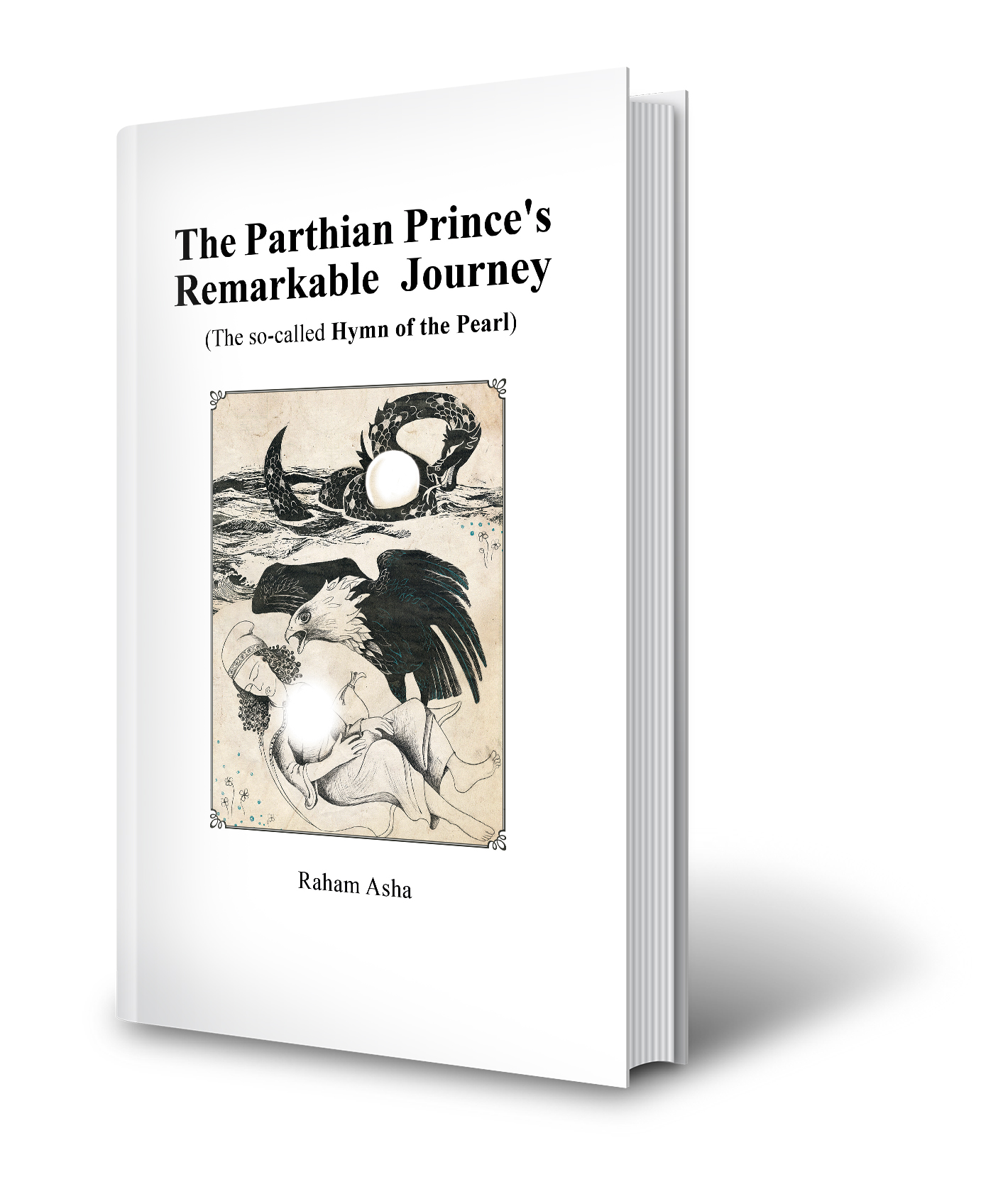Raham Asha, The Parthian Prince’s Remarkable Journey (The so-called Hymn of the Pearl), First published, Arrou, Alain Mole, 2021, ISBN 978-2-9579653-0-4, EAN 9782957965304; Second published, Tehran, Sade, 2022, ISBN 978-600-8968-58-0.
Contents
Foreword
List of Abbreviations
Introduction 15-41
I. Srōd 43-49
Syriac and Greek versions 51-98
Notes on the Syriac and Greek versions 99-162
II. A parable of Zaraθuštra 163-166
A Sogdian fragment containing the parable of pearl-borer and the division of the day into three parts 167-185
From the Prologue of Burzōyag 186-188
From the ēvēn ī ardašēr 189
From the Book of Kāvus 190
Foreword
Since 1871, when the text of the Parthian Prince’s Remarkable Journey (also called the Hymn of the Pearl) was edited, western scholars have devoted a great many studies to it.[1] W. Wright who first edited it from Syriac manuscripts, found it “a most curious document”, and especially “out of place” in the Acts of Thomas.[2] Macke, one of pioneers in the research of the Hymn, found it one of the most difficult, most inexplicable products of Syrian literature, and perhaps also the oldest product of independent poetry by the Syrians; and hesitatingly attributed it to Bardesanes “the Gnostic”.[3] The Hymn itself has been understood as an expression of Gnosticism, Manichaeism, Christianism, or Buddhism; the adventures of the hero of the Hymn have been compared with the life of Bardesanes, Cerdo (Κέρδων), Mani, Christ, Thomas; and the composition of the Hymn has been attributed to Bardesanes, Mani or a Manichaean, a Christian or even a Jewish one.
Indeed, the Hymn has many points in common with any of these doctrines. It is even probable that it inspired some gnostic writers. But as Manichaeism provides a distorted and perverted version of Mazdaism, some gnostic texts also give a distorted version of the Hymn. By outlining some commonalities, it is easy to attribute the Hymn to any religious milieu.[4]
As an example, Geo Widengren found in a segment of the epic Persian (originally, Parthian) romance, Vēs u Rāmēn, an allusion to the Hymn:
You cross the sea, without a boat,
looking for the royal pearl from it.
I do not know what the outcome of your deed will be,
whether the life-time will show you good or bad.
You are months and years with that dragon
from which nobody (/ no enemy) can escape:
One day, it will stand in your way,
and will take its revenge by catching you.[5]
It is true, as Widengren indicated, in this fragment there exists the same link (Verknüpfung) sea-pearl-dragon-prince as in the Hymn.[6] Even if we have the same series in both texts, however the spirit of the Hymn of the Pearl is not the same as that of the Vēs u Rāmēn. The narrative in the Vēs u Rāmēn has been inspired by the Avesta poem Aogǝmadaēcā, and the dragon in that roman is the death (Av. vaya-) that follows any living being.
The book consists of two parts:
It begins with an introduction. The purpose of the Introduction is double: To present a survey of man’s destiny in the Mazdaean doctrine that sheds light on the destiny of the Parthian prince described in the Hymn, and to give a sketch of Mazdaism in the light of the Hymn.
Then comes the text of the Hymn, in Pārsīg with English translation. I have prepared the Pārsīg poem, and Ātar Torābi, who is a skilled musician as well as a savant, has started composing the music for it.
This is followed by Syriac and Greek versions, with English translations, as well as the notes to clarify these versions and especially some difficult terms used by the poet or translator.
The second part provides one text, in Persian, that was probably inspired by the Hymn. It ends with a parable in two languages, Sogdian and “Pārsīg”.
Finished with joy aṣǝm
Raham Asha
gōš rōz ī fravardīn māh ī sāl 1391 yazdegirdīg ped rōstāg ī Arrou
Notes
[1] . Paul-Hubert Poirier gives a comprehensive history of these studies in his book, L’hymne de la perle des Actes de Thomas, Louvain-la-Neuve, 1981.
[2] . “It is certainly wholly out of place in the mouth of the Apostle, and we need not therefore wonder at its absence from the Latin text.” W. Wright, Apocryphal Acts of the Apostles, London, I, 1871, I.xiv.
[3] . “Es ist mit das schwierigste, unerflärlichste product der syrischen Literatur, und auch vielleicht das älteste Product selbständiger Dichtung der Syrer. Ein Berfasser ist vielleicht Bardesanes der Gnostiker.” Carl Macke, Hymnen aus dem Zweiströmeland, Mainz, 1882, 246.
[4] . For example, « La façon dont Bevan aborde la question de l’auteur de l’HP, est assez proche de celle de Macke. Une fois admis le caractère gnostique de l’œuvre, il ne reste plus qu’à faire l’inventaire des courants gnostiques qui circulaient dans le monde syriaque avant 224-226, et d’attribuer l’hymne à celui de ces courants dont il se rapproche le plus. » Poirier, op.cit., 58.
[5] . Vēs u Rāmēn, 70: 56-59.
تو بيکشتی همی دريا گذاری ازش جوينده درّ ِ شاهواری
نه دانم چون بود فرجام ِ کارت چه نيک و بد نمايد روزگارت
تو سال و ماه با آن اژدهائی که از وی نيست دشمن را رهائی
مگر يک روز بر تو راه گيرد ز کين ِ دل تو را ناگاه گيرد.
ويس و رامين، فخر الدين اسعد گرگانی، ۷۰: ۵۹-۵۶ (م. روشن، تهران، ۱۳۷۷، ۲۲۴).
[6] . G. Widengren, Iranische Geisteswelt: Von den Anfängen bis zum Islam, Bertelsmann Lesering, 1961, 255-256.
Purchase
It is advisable to forward your request via email to the Perso-Aryan Studies email address provided below:
PersoAryanStudies@gmail.com
نگاهی به کارِ تازهی رهامِ اشه بر «سرودِ مروارید»: چگونه پرده از رازِ زیباترین سرودِ جهان برداشته شد؟






